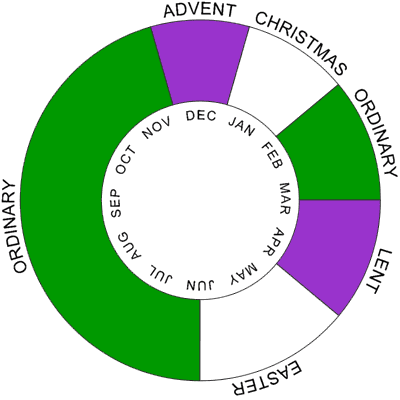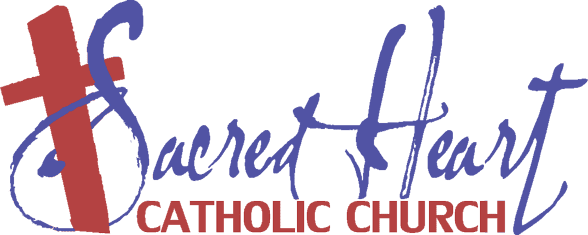The Catholic Church sets aside certain days and seasons of each “year” to recall and celebrate various events in the life of Christ. Our “liturgical year” does not correspond to the calendar, but rather begins with the Season of Advent – as seen in the graphic. As we move through the liturgical year, each celebration of Mass is accompanied by readings from the Old Testament, New Testament, and the Gospels.

The Gospels are organized into a three-year cycle, designated A, B, or C. Year B follows year A, year C follows year B, then back again to A.
- Year A: Gospel of Matthew
(December 2016 through November 2017) - Year B: Gospel of Mark
(December 2017 through November 2018) - Year C: Gospel of Luke
(December 2015 through November 2016)
The Gospel of John is read throughout Easter, and is used for other liturgical seasons including Advent, Christmas, and Lent where appropriate.
Season of Advent
Advent is a time of watchful, joyful, and hopeful preparation for the Coming of the Lord, both the “first coming” of Jesus (Christmas) and his “second coming” (Parousia).
- Advent begins four Sundays before Christmas; thus it is between three and four weeks long, but only rarely four full weeks
- Scripture Readings and Liturgical Prayers are slightly different for the three parts of Advent:
- Beginning of Advent: focus is on Eschatology and Messianic expectations, teachings about the future or end-times (esp. from the prophet Isaiah).
- Middle of Advent: readings from Isaiah continue, but focus shifts to Gospel texts about John the Baptist, the one who prepared for the coming of Jesus.
- Dec. 17-24 (last week before Christmas): focus is on the biblical events that immediately preceded the birth of Jesus; readings from Matt 1 & Luke 1 and special “O Antiphons.”
Season of Christmas
The Season of Christmas celebrates the Incarnation/Nativity/Birth of Jesus Christ. Not just Christmas Day itself, but a season of continued celebration for several weeks afterward. The exact length of the Christmas Season varies from year to year.
- Christmas Day: always on Dec. 25 (technically beginning on the evening of Dec. 24), so it can occur on any day of the week.
- Includes four different Masses (with different sets of prayers and readings): Vigil, Mass during the Night (popularly known as “Midnight Mass”), Dawn, and Daytime.
- Christmas Octave: intensive celebration for eight days, up to and including Jan. 1.
- Includes several special feasts: St. Stephen, St. John, Holy Innocents, Holy Family, and Mary, Holy Mother of God.
- Christmas Season: celebration continues through the Epiphany, up to the Baptism of the Lord.
- The Epiphany of the Lord was traditionally celebrated on Jan. 6 (the twelfth day of Christmas); now it is often transferred to the Sunday between Jan. 2 and Jan. 8.
- The Baptism of the Lord is usually celebrated on the Sunday after Epiphany; but if Epiphany is Jan. 7 or 8, then the Baptism is celebrated on the following Monday.
Season of Ordinary Time – I (begins)
This liturgical season can also be called “Ordered Time” or the “Season of the Year” (when Sundays are sequentially numbered).
- The first part of “Ordinary Time” begins after the Christmas season (the day after the Baptism of the Lord) and runs up until Lent (which begins on Ash Wednesday).
- It varies in length between four and nine weeks (since the Christmas Season can end between Jan. 8 and Jan. 13, and Lent can begin as early as Feb. 5 or as late as Mar. 10).
- Anglicans and some Protestant Christians call this part of “Ordinary Time” the “Season of Epiphany.“
Season of Lent
A season of preparation for Easter, Lent has both a penitential and baptismal character. Traditional penitential practices during Lent include fasting, prayer, and almsgiving. For those preparing to be baptized at Easter, the “Rite of Christian Initiation of Adults” (R.C.I.A.) includes a “Rite of Election” (usually done early in Lent) and three “Scrutinies” (done on the 3rd, 4th, and 5th Sundays of Lent).
- Lent is traditionally thought to be “forty days” long, but its actual length has changed over the centuries In contemporary understanding, Lent begins on Ash Wednesday and ends on Holy Thursday afternoon.
- Ash Wednesday: a day of fasting and abstinence; Catholic Christians receive a cross of ashes on our foreheads as a sign of our mortality and repentance.
- Palm Sunday or Passion Sunday: the Sunday before Easter; the entry of Jesus into Jerusalem is commemorated and the Synoptic Passion Narratives are read (Matthew, Mark, and Luke, on a 3-year rotating cycle).
- Holy Week: the week before Easter, beginning Palm Sunday (also known as Passion Sunday) and including the Easter Triduum (Good Friday, Holy Saturday, and Easter Sunday).
Season of Easter
The Season of Easter celebrates the “Paschal Mystery:” the Death & Resurrection of Jesus Christ (the core/central event of Christianity).
- The date of Easter is variable on the solar calendar; it falls on the first Sunday after the first full moon after the vernal equinox.
- It is celebrated on a different day by some Eastern Christians, who still base their liturgical calendar on the Julian calendar (in contrast to the Gregorian calendar).
- Easter Triduum: “three holy days” from Holy Thursday evening to Easter Sunday evening:
- Holy Thursday: commemorates the “Last Supper” of Jesus with his disciples; the liturgy traditionally includes “the Washing of the feet” and is followed by a Eucharistic procession and a period of veneration of the Blessed Sacrament.
- Good Friday: commemorates the Passion, Death, and Burial of Jesus; a special non-Eucharistic liturgy focuses on the Johannine Passion, the Veneration of the Cross, extensive Intercessory Prayers, and sharing of Communion.
- Holy Saturday: commemorates the time when Jesus was in the tomb; no liturgical rites should be celebrated on this day (not before sundown).
- Easter Vigil: begins the liturgical celebration of the Resurrection of Jesus; a special liturgy (celebrated Saturday after sunset, during the night, or Sunday before dawn) includes lighting of the Easter Fire and Easter Candle, proclamation of the Easter Exsultet, extensive readings from the Old Testament, and the Baptism of many new Christians.
- Easter Sunday: the day of Jesus’ Resurrection; the liturgy includes the renewal of Baptismal Promises for all the faithful.
- Easter Octave: eight days of intensive celebration, from Easter Sunday to the 2nd Sunday of Easter (now also known as “Divine Mercy Sunday” by Roman Catholics).
- Easter Season: a continued celebration for a full fifty days (seven weeks) up to and including the Feast of Pentecost.
- Ascension of the Lord: traditionally celebrated on the 40th day of Easter; now often moved to the following Sunday.
- Pentecost Sunday: seven weeks or fifty days after Easter, celebrating the coming of the Holy Spirit upon the first disciples.
Season of Ordinary Time – II (continues)
The Season of Ordinary Time – II is the rest of the liturgical year (up to 34 weeks total), from the Monday after Pentecost Sunday until the First Sunday of Advent, which begins the next liturgical year. Exactly when Ordinary Time resumes depends on the variable date of Pentecost.
- Several special celebrations fall soon after Pentecost:
- Most Holy Trinity: on the Sunday after Pentecost
- Body and Blood of Christ: traditionally Thursday, now the Sunday after Trinity Sunday
- Sacred Heart of Jesus: Friday after the second Sunday after Pentecost)
- Many other celebrations related to Jesus or to Mary or other Saints can be celebrated on weekdays during Ordinary Time.
- Some of these can even be celebrated on Sundays.
- The 34th or Last Sunday of Ordinary Time is celebrated as the Feast ofChrist the King.
- Anglicans and some Protestant Christians call this second and larger part of Ordinary Time the “Season of Pentecost.”
Liturgical Colors: The changing of the liturgical season is also accompanied by a change in the colors used for altar linens and the vestments of the celebrating priests and deacons.
- Advent – Purple on most days, except for Rose (optional) on the Third Sunday of Advent (“Gaudete Sunday”).
- Christmas – White or Gold (not red and green!), except for Red on the feast days of martyrs.
- Lent – Purple on most days; Rose (optional) on the Fourth Sunday of Lent (“Laetare Sunday”); Red on Passion/Palm Sunday.
- Easter Triduum – White or Gold on Holy Thursday and at the Easter Vigil; Redon Good Friday.
- Easter Season – White or Gold on most days, except for Red on Pentecost Sunday.
- Ordinary Time – Green, except for particular feasts or occasions that have other designated colors.
- Special Colors for Particular Celebrations within any Liturgical Season:
- White – Solemnities of the Lord and the Saints; memorials of saints (other than martyrs); major local feasts; and funeral liturgies (Black is now also allowed again for funerals).
- Red – Feasts and memorials of the Apostles, Evangelists, Martyrs, or the Holy Spirit, almsgiving is also emphasized.





